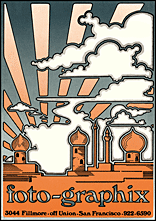
Click on image for detail
#(9) FOTO-GRAPHIX
First edition of 500 of which one copy is signed.
1971 Three colors 17" x 24"
Client: Roger Mulkey, Foto-Graphix Signed copy to The Poster, San Francisco
Second printing of 1000, of which 100 copies are signed. No alterations.All signed copies to The Poster, San Francisco 1973 No alterations.
Influence: Camel cigarette package
Though there is nothing new under the Sun, there are new ways of looking at the old sun-washed landscape. Everybody learns from everybody else. This has been going on for a long time. Once in a while, somebody comes up with a twist on an old idea that really moves things along: our A-B-C alphabet is perhaps the best ever.
Short inscriptions carved by turquoise miners at Serabit al-Khadim in Sinai from about 1700 bc onwards indicate that the alphabet was invented in Palestine or Syria, probably between 1800 and 1650 bc. These areas were under strong Egyptian influence, and that influence is very clear in the origin of the alphabet. The Egyptians, in turn, got their writing system from the Sumerians. They did not simply take over the Sumerian script as it was, neither was their writing an entirely independent invention. This is what A. L. Kroeber called "stimulus diffusion," which is the indirect transfer of ideas from one group to the next.
In the 1920s, the unearthing of the treasures of the tomb of King Tutankhamen provoked an Egyptian craze which echoed back to an earlier Egyptian craze of the mid-19th century. These Egyptian-Deco design treatments are preserved in the Camel cigarette package. In the late 1960s, Bay Area graphic artists became fascinated with its motifs, and worked them into posters. Old solutions to new problems."The thing that has been, it is that which shall be; and that which is done is that which shall be done: and there is no new thing under the sun."- Ecclesiastes; or, The Preacher 1:9